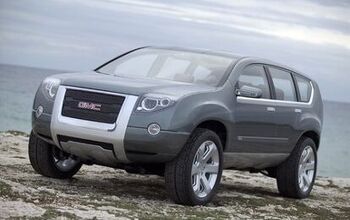General Motors Death Watch 87: Dead Beat
A few days after GM's vice president of vehicle sales, service and marketing assured auto industry analysts that his employer will maintain incentive-free “value pricing," General Motors announced two grand cash back on the 2007 Chevrolet Tahoe, Avalanche and Suburban and the GMC Yukon, Yukon XL and Denali. To be fair, nobody took LaNeve’s price promise seriously. By now, everyone knows GM’s new(ish) SUV’s are a drug on the market, and it ain’t Viagra. There’s only way to move the metal: lower the price. Either that or stop making the damn things.
Last Friday (always Friday), GM CEO Rick Wagoner announced that The General will curtail production of its GMT-900 based SUV’s. Rabid Rick tried to minimize the damage by asserting that GM was going to halt “some overtime” on SUV assembly lines and introduce “other products” into the production mix— as if to say demand for GM’s gas guzzlers was still hot, just not sizzling, and besides, we can make some other stuff instead.
Yeah right. At the end of July, in an industry where a 60-day supply is an acceptable maximum, GM dealers were stuffed to the gills with Tahoes (82 days), Yukons (89 days) and Chevrolet Suburbans (75 days). Although the figures are not far off last year's, these are GM's "new" trucks. August is going to be a bitch.
Meanwhile, Rabid Rick proclaimed that GM's share of the full-size SUV market has “boomed.” According to Wagoner, GM now “owns” 50 to 75 percent of various segments within the SUV genre— which is a bit like saying you’ve scored the best cabins on the Titanic after it hit the iceberg. The executive’s statement was a remarkable piece of spin, but it pales in comparison to GM’s creative accounting. Lest we forget, Rabid Rick ascended to his throne as GM Chief Financial Officer. Here’s a bit of what he’s learned…
Yesterday, The General’s GMAC finance unit signed a three-year, $10b funding facility with a Citigroup subsidiary. Four billion dollars of the money falls into a brand new category for GMAC: “unrated notes”. Unrated notes are papers representing loans that are so far outside traditional credit parameters that the vast majority oif insitutional investors are literally prohibited from buying them.
In other words, GM’s “Zero Percent for Deadbeats” summer blowout left GMAC with billions of dollars of risky loans. No surprise then that GM's finance arm reported that the unrated notes are backed by assets “not typically securitized by GMAC.” OK, here's the "creative" part…
Because the risk is so high, there's a gap between the money GMAC lent its less-than-perfect customers and the amount of money Citigroup paid for the loans. As part of the deal, GM has agreed to cover the shortfall (i.e. securitize the assets). It’s all a bit confusing (by design), but here’s the bottom line: GMAC carries little or no risk for the bad loans. GM buries a “charge” in its sales costs to cover the money paid to GMAC for the dicey loans.
The shell game maintains the illusion of higher average transaction prices, hides huge discounts/rebates and moves vehicles off the lot. Given that GM generates about $28b in North American sales per quarter, $4b in bad debt equals about 15% of sales (assuming 100% financing). Since most of this paper was written in 60 days, as much as 40% of GM's recent sales surge may be directly attributable to bad loans. Put that in your quarterly report and smoke it.
Just like last year’s “Fire Sale for All” program, the “Zero Percent for Deadbeats” program will eventually bite GM in the ass. Can you imagine what these vehicles will be worth when (not if) they’re repossessed? At the risk of sounding, um, deadbeatist, people with sub-basement level credit scores tend to smoke, spill beer, puke, rip up interiors, ding ‘em good and never fix a thing. And speaking of repairs…
In the second financial quarter, GM downgraded its warranty expenses per vehicle to $325 (compared to $523 for the same quarter in ’05). GM’s improving reliability record is admirable, but it doesn’t justify that kind of drop. The revised figure added $433 million (the equivalent of $0.67 a share) to GM’s second quarter “profits.” Clearly, GM is ducking and diving, window dressing its earnings to mask the company’s true performance, or lack thereof.
The truth is things are not going well at RenCen. While GM has finalized its new credit line of $4.5b (on onerous terms), the company still withdrew an additional $2b from its VEBA on July thirty-first to cover health care reimbursement. GM’s continual need to tap into the VEBA account suggests a cash shortage.
Now that the GMAC sale has been postponed until next year, the need for operating funds could well become critical. While the risk of a GM default may not be imminent, a strike at bankrupt auto parts maker Delphi would be the tipping point. In the event of a work stoppage, GM’s credit line would be reduced by a billion dollars.
Industry watchers still say it’ll never happen. Meanwhile, negotiations at Delphi are stalled and the most recent final deadline arrives in two days. If Delphi goes down, GM goes down. If it doesn’t, the company's descent into bankruptcy will merely be postponed.
More by Robert Farago
Latest Car Reviews
Read moreLatest Product Reviews
Read moreRecent Comments
- Kjhkjlhkjhkljh kljhjkhjklhkjh A prelude is a bad idea. There is already Acura with all the weird sport trims. This will not make back it's R&D money.
- Analoggrotto I don't see a red car here, how blazing stupid are you people?
- Redapple2 Love the wheels
- Redapple2 Good luck to them. They used to make great cars. 510. 240Z, Sentra SE-R. Maxima. Frontier.
- Joe65688619 Under Ghosn they went through the same short-term bottom-line thinking that GM did in the 80s/90s, and they have not recovered say, to their heyday in the 50s and 60s in terms of market share and innovation. Poor design decisions (a CVT in their front-wheel drive "4-Door Sports Car", model overlap in a poorly performing segment (they never needed the Altima AND the Maxima...what they needed was one vehicle with different drivetrain, including hybrid, to compete with the Accord/Camry, and decontenting their vehicles: My 2012 QX56 (I know, not a Nissan, but the same holds for the Armada) had power rear windows in the cargo area that could vent, a glass hatch on the back door that could be opened separate from the whole liftgate (in such a tall vehicle, kinda essential if you have it in a garage and want to load the trunk without having to open the garage door to make room for the lift gate), a nice driver's side folding armrest, and a few other quality-of-life details absent from my 2018 QX80. In a competitive market this attention to detai is can be the differentiator that sell cars. Now they are caught in the middle of the market, competing more with Hyundai and Kia and selling discounted vehicles near the same price points, but losing money on them. They invested also invested a lot in niche platforms. The Leaf was one of the first full EVs, but never really evolved. They misjudged the market - luxury EVs are selling, small budget models not so much. Variable compression engines offering little in terms of real-world power or tech, let a lot of complexity that is leading to higher failure rates. Aside from the Z and GT-R (low volume models), not much forced induction (whether your a fan or not, look at what Honda did with the CR-V and Acura RDX - same chassis, slap a turbo on it, make it nicer inside, and now you can sell it as a semi-premium brand with higher markup). That said, I do believe they retain the technical and engineering capability to do far better. About time management realized they need to make smarter investments and understand their markets better.


































Comments
Join the conversation
This Chinese market is all fine and good except for a couple of flys in the soup. GMs Chinese operations (as other non-Chinese companies) is only a 50/50 joint venture (in GMs case, with Shanghai aka SAIC, which also has a 50/50 JV with Volkswagen, and bought rights to the Rover designs before Rover imploded, also SAIC owns a portion of "GMDaewoo" and 49% of Ssangyong in South Korea). So, how "dedicated" is SAIC towards the GM JV? They are planning on building cars in COMPETITION with GM and VW for EXPORT soon. The other "catch" is that if GM thinks the 50% owned JV in China is going to carry the rest of their worldwide automotive operations when North American operations is sinking, sinking, sinking - they had better go back to Econ 101. Ain'tgonnahappen dot com. In case everyone's forgotten, the People's Republic of China is a communist state run by a few, and they can change anything on a whim. Like nationalize auto companies, or prevent profits from leaving from JVs, or raise interest rates (they just did that) to slow down the economy. Whatever. The GM guys and the rest of the western JV part-owners had better figure out that they can't simply control everything down at the Mason lodge any more. As in, the tiller isn't in their hands. So, they can join the rest of us, who've never had a tiller in our hands, controlling billions of dollars and millions of lives.
The China market in aggregate is still tiny, and is seeing even higher levels of competition. VW is the established player, and there was a boom in local manufacturing. Add to this FDI in factories (Buick, Toyota - Corolla and Camry are both now built in-country in China), and you come up with... a massive case of oversupply. The Chinese auto market, despite growing dramatically, is still growing slower than production capability - prepare for a winnowing ahead.